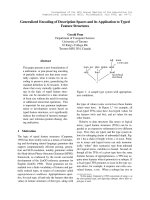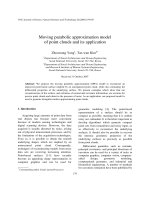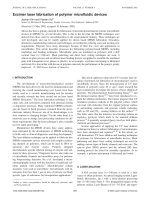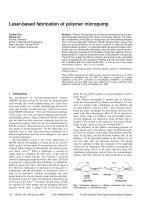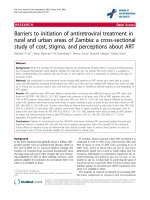Fabrication of cost effective and flexible polymer nanostructured substrate for bio and magnetic application
Bạn đang xem bản rút gọn của tài liệu. Xem và tải ngay bản đầy đủ của tài liệu tại đây (9.75 MB, 186 trang )
i
FABRICATION OF COST-EFFECTIVE AND FLEXIBLE
POLYMER NANOSTRUCTURED SUBSTRATE FOR BIO-
AND MAGNETIC APPLICATIONS
LI BIHAN
NATIONAL UNIVERSITY OF SINGAPORE
2014
ii
Fabrication of Cost-effective and Flexible Polymer
Nanostructured Substrate for Bio- and Magnetic Applications
LI BIHAN
B. Eng. (Hons.), NUS
A THESIS SUBMITTED
FOR THE DEGREE OF DOCTOR OF PHILOSOPHY
Department of Electrical and Computer Engineering
NATIONAL UNIVERSITY OF SINGAPORE
2014
iii
Declaration
I hereby declare that the thesis is my original work and it has been written by me
in its entirety. I have duly acknowledged all the sources of information which have been
used in the thesis. This thesis has also not been submitted for any degree in any university
previously.
LI BIHAN
1 Dec 2014
iv
Acknowledgements
This project would not have been possible without the guidance, support and
constant encouragement of many individuals. Firstly, I would like to express my
deepest gratitude to my thesis supervisor, Professor Choi Wee Kiong for his
invaluable guidance and instruction during the progress of my research.
As most of the research work was conducted in the Microelectronics
Laboratory, at NUS, I would like to extend my greatest gratitude to Mr. Walter Lim,
Ms. Xiao Yun, and Ms Ah Lian Kiat for all the kindest assistance rendered during the
course of my research.
Next, I would like to thank my fellow lab-mates and friends who have given
me a lot of insights and encouragements. They are Zhu Mei, Cheng He, Zongbin,
Changquan, Ria, Yudi, Raja, Khalid, Zheng Han, Thi and Wang Kai. I would also like
to acknowledge the help provided by Dr. Liu Xin Min and Professor AO Adeyeye in
preparing the magnetic samples used in this work.
Last but not the least, this thesis is especially dedicated to my parents and wife
Yujie who have been supporting me throughout my studies. Their indefinite love has
made all the difference.
v
Table of Contents
Declaration ………………………………………………………………………… i
Acknowledgements iii
Table of Contents…………………………………………… ………………….iii
Summary vvii
List of Tables…………………………………………………………………….……x
List of Figures……………………………………………………………………….…xi
List of Symbols …………………………………………………………………….xxiii
Chapter 1 Introduction 1
1.1 Background 1
1.2 Motivation 2
1.3 Objectives 3
1.4 Organization of thesis 4
Chapter 2 Synthesis of Polyethylene Terephthalate Nanostructures 6
2.1 Introduction 6
2.2 Literature Review 8
2.3 Fabrication of PET Nanostructures by O
2
Plasma Etching 17
vi
2.3.1 Fabrication of Nanogrooves 17
2.4 Fabrication of PET Nanostructures by Sputter Etching with Ar 27
2.5 Fabrication of PET Nanopillars with Al Hard Mask 33
2.6 Fabrication of PET Nanoholes 35
2.7 Summary 40
Chapter 3 Neurite Outgrowth and Guidance on Nanogroove Arrays 42
3.1 Introduction 42
3.2 Literature Review 44
3.2.1. Directed Neural Growth on Nanostructured Surfaces 44
3.2.2 Role of microRNAs on Directed Neural Growth 48
3.3 Neurite Outgrowth/Guidance on Nanogroove Arrays 52
3.3.1 Fabrication of Si and Polyimide Nanogrooves 52
3.3.2 Neurite Outgrowth/Guidance on Nanostructured Surfaces 55
3.4 Investigation of miRNA Involvements in Topological Guidance of Neurite
Outgrowth 62
3.5 Summary 73
vii
Chapter 4 Synthesis of Co/Pd Nanodiscs on Polyethylene Terephthalate
Substrate 74
4.1 Introduction 74
4.2 Literature Review – Devices on Flexible Substrates 76
4.3 Fabrication of Co/Pd Nanodiscs on PET Substrates 87
4.4 Influences of Process Parameters on Magnetic Properties of Co/Pd Nanodiscs 92
4.4.1 Effect of Au Intermediate Layer 92
4.4.2 Effect of PET Substrate 96
4.4.3 Co/Pd Multilayer Film versus Nanodisc Arrays 102
4.5 Effect of stress on Co/Pd film and nanodisc arrays on PET substrate 105
4.6 Summary 114
Chapter 5 Conclusions and Future Work ………………………………… … 117
5.1 Summary 117
5.2 Future work 120
5.2.1 Improvement in Aspect Ratio of Polymer Nanostructures 120
5.2.2 Integration of Electronic Components with Flexible Substrate
for Bio- Study 120
viii
5.2.3 Stress Study on Magnetic Nanodiscs on Flexible Stubstrates
121
References …………………………………………………………………… ….121
Appendix 1 Experimental Techniques 137
Section 1 Spin Coating 137
Section 2 Thermal Evaporation 138
Section 3 DC Magnetron Sputtering Deposition 139
Section 4 Lift-off 140
Section 5 Plasma Etching 141
Section 6 Poly(dimethylsiloxanes) Preparation 142
Section 7 Scanning Electron Microscopy 144
Section 8 Atomic Force Microscopy 146
Appendix 2 Techniques of cell study for MicroRNA studies 149
Section 1 ChemoMetec Measurements of Cells on Different Substrates 149
Section 2 Cell Mortality Study 149
Section 3 Prediction of Downstream Targets and Tested miRNAs 156
Appendix 3 List of Publications 159
ix
Summary
This study focused on fabrication of cost-effective and flexible polymer
nanostructured substrate for Bio- and Magnetic applications.
Firstly, we reported results of synthesis of nanostructures on low cost, off the
shelf, office transparency sheet substrates made of polyethylene terephthalate (PET)
by using interference lithography (IL) and plasma etching techniques.
Nanostructures were first created using O
2
plasma. The etching was chemical and
isotropic. This method was only successful in creating nanogrooves. Nanostructures
with higher aspect ratio such as nanopillars were fabricated using Ar sputter etching.
Ar sputter etching was physical etching and more anisotropic with a DC biased
applied. Influence of chemical and physical etching mechanisms on the synthesis of
nanostructures were discussed. In sputter etching, photoresist (PR) was used as
etching mask. The etch selectivities of PR and PET were similar so that the height
of the achieved nanostructures was limited by the height of the PR. Aluminum hard
mask with lower etch selectivity was used to further increase the aspect ratio of the
fabricated nanopillars.
Secondly, we focused on the study of neurite outgrowth on nanostructured
substrates. The experiments were first carried out on Si based nanostructures. We then
demonstrated the fabrication of polyimide nanogrooves using Si nanogrooves as the
master for the study. Eventually, nanogrooves fabricated on PET substrates were used
for neurite outgrowth. With the PET nanogrooves, we examined the role of
x
MicroRNAs (miRNAs) in the outgrowth of neurites guided by topological cues. The
less costly and transparent nature of the polymer substrates poses advantages over
silicon substrates. With the supply of large quantity of cheap, large area of uniformly
patterned PET substrates, we were able to carry out the investigation on the
participation of microRNAs on directed neuronal growth of cells. Three microRNAs
were identified to affect the neurite guidance.
Lastly, we reported the fabrication and characterization of the Co/Pd film and
Co/Pd nanodisc arrays on flexible and transparent PET substrates. The nanodisc
arrays were patterned using the interference lithography (IL). The magnetic properties
of the Co/Pd multilayer films and nanodisc arrays were characterized using the polar
magnetic-optical Kerr effect (MOKE). The effects of surface roughness of the PET
substrate and the reflective gold (Au) layer on top of the PET substrate on the
magnetic properties of the films and nanodisc arrays were systematically investigated.
We carried out investigation of the effect of stress on Co/Pd film and nanodisc arrays
on PET substrate.
In conclusion, the findings in this thesis added to the knowledge of fabrication
of polymer nanostructures. The applications on directed neurite cell growth and
flexible magnetic device demonstrated the diverse applications of polymer materials
and provided ground work for future studies.
xi
List of Tables
Table 2.1 Comparison of different fabrication techniques…………………
…….……
16
Table A2S3.1 miR-124 targets tested………………………………………………158
Table A2S3.2 miR-221 or miR-222 targets tested…………………………… ….158
xii
List of Figures
Figure 2.1 SEM images of PET nanostructures etched in O
2
plasma (A) for different
durations with power fixed at 100W [63] and (B) at different plasma power for 10
min.[65] ……………………………………………………………………
…………
10
Figure 2.2 SEM image of polyimide pillars. [70]……………………………… ….11
Figure 2.3 (A)–(C) Schematic diagrams of the fabrication steps. (A) Parylene is
partially shielded with cover glass in RIE etching and then (B) the sample is
positioned for RIE etching. (C) During the RIE process, nanomasks are scattered onto
the entire surface, including the cover glass (dummy material). (D) SEM image of
nanopillars. Inset: enlarged SEM photo of nanopillars (H ~ 3.7μm, D ~ 155nm, scale
bar: 1μm). [71] 12
Figure 2.4 Schematic plots of growing polymer nanostructures using a bottom-up
method. (A) The electrostatic pressure acting at the polymer (grey)-air interface
causes instability in the film (left). Eventually, polymer columns span the gap
between the two electrodes (right). (B) If the top electrode is replaced by a
topographically structured electrode, the instability occurs first at the locations where
the distance between the electrodes is smallest (left). This leads to replication of the
electrode pattern (right). [72]………………………………………………… 13
Figure 2.5 Schematic diagrams of the Si mold fabrication and NIL process to make
high density polymer nanopillars over large areas. (A) Placing a freestanding anodic
xiii
alumina membrane on top of a Si substrate. (B) Ar plasma etching to remove the
rough barrier layer of the AAM. (C) Cl2 and Ar plasma etching to create Si nanopores
using AAM as a mask. (D) After AAM removal, the perfluorodecyltrichlorosilane
treated Si mold is used for nanoimprint lithography. (E) Formation of polymer
nanopillars after releasing the Si mold from the substrate. [82] …………………….14
Figure 2.6 Schematic diagrams of fabrication process of the PDMS hair arrays using
casting molding method [83]…………………………………………………… …….15
Figure 2.7 Schematic diagram of the Lloyd’s mirror interference lithography
system 19
Figure 2.8 Schematic Illustrations of patterning process using IL………… ………19
Figure 2.9(A) to (D) are schematic diagrams showing fabrication steps of the creation
of nanogroove arrays on transparency, and (E) is a SEM image of the fabricated
nanogrooves……………………………………………………………………… ….21
Figure 2.10 AFM images of nanogrooves fabricated using oxygen plasma…………22
Figure 2.11 Schematic illustration showing vertical etching and lateral etching……22
Figure 2.12 Results of etch rate as a function of plasma etching conditions (O
2
pressure and RF power) obtained using a PECVD machine. The solid lines are results
for different RF power with O
2
pressure fixed at 0.4 Torr. The dotted lines are for
different O
2
pressure but with RF power fixed at 40 W…… …………………… 24
xiv
Figure 2.13 SEM picture of failed attempt to create nanopillars using PECVD
machine with O
2
plasma at 40W for 15min……….…………………………………25
Figure 2.14 SEM picture of failed an unsuccessful attempt to create nanopillars using
RF sputtering with O
2
ambient……………………………………………………….26
Figure 2.15 (A) Scanning electron micrograph image and (B) atomic force
micrograph image of a nanogroove sample etched for 15 min in Ar plasma using
PECVD machine at RF power of 30 W and chamber pressure of 0.4 Torr………….28
Figure 2.16 Schematic diagrams showing the lateral etch caused by backscattered
ions………………………………………………………………………………… 28
Figure 2.17 (a) Results of etch rate versus plasma etching conditions (Ar pressure and
RF power) obtained using a PECVD machine. The solid lines are results for different
RF powers with Ar pressure fixed at 0.4 Torr. The dotted lines are for different Ar
pressures but with RF power fixed at 40W. (b) SEM image of the failed attempt to
create nanopillars using PECVD machine with Ar plasma at 40 W for 15
min……… 30
Figure 2.18 SEM images of nanostructures fabricated on transparency (A) Ar
sputtered Nanogrooves with diameter of 400nm and height of 650 nm. (B) Photoresist
nanopillars (C) Ar sputtered Nanopillars (D) Ar sputtered Nanofins…………… 32
Figure 2.19 AFM images of nanostructures by sputter etching: (A) nanogrooves (B)
nanofins………………………………………………………………………………33
xv
Figure 2.20 Schematic diagrams showing fabrication process of long nanopillars with
Al mask…………………………………… ……………………………………….34
Figure 2.21 SEM images of sputtered nanopillars using PR/Al mask………… … 35
Figure 2.22 Process flow to create Al hole template…………………………………36
Figure 2.23 (A) and (B) are nanoholes etched in PECVD machine with RF power of
40 W and chamber pressure of 0.4 Torr for 15 min using O
2
and Ar plasma,
respectively, (C) nanoholes etched by Ar sputtering with RF power of 50 W, chamber
pressure 0.5 Torr for 100 s. (D) to (F) are the PDMS negative replica of (A)–(C)
respectively… 37
Figure 2.24 SEM images of Al hole template and resulting PET holes after being
etched in Ar plasma at 75 W for 15 min. (A) Small holes defined by IL, with Al hole
diameter around 400 nm and PET hole diameter more than 650 nm after etching; (B)
Big holes defined by optical lithography, with Al hole diameter around 2.41 μm and
PET hole diameter 2.52 μm after etching…………………………………………….39
Figure 3.1 Morphologies of neurons and neurite extension in SEM and CLSM. (A)
Fluorescence image on flat film (staining for β-tubulinIII), (B) SEM image on flat
film, (C) Fluorescence image on groove patterned film (staining for β-tubulinIII) with
width: 3.6 μm, spacing: 8.4 μm, (D) SEM image on groove patterned film with width:
3.6 μm, spacing: 8.4 μm (E) Phase contrast images on groove width: 2.2 μm, spacing:
6.1 μm and (F) Groove width: 4.3 μm, spacing: 12.7 μm [99] 44
xvi
Figure 3.2 A: Schematic representation of a surface consisting of two planar areas and
an area with parallel ridges. Growth cones (black arrows) growing out from a
reaggregate of spinal cord neurons (black circles, placed in one of the planar areas)
into the topographically structured area. The grey rectangle corresponds to the area
shown in the images below; the black rectangle is the selected field for live
monitoring as shown in Figure 3.2 B–L: SEM images of topographical structures, B
5-5; C 10-10; D 25-25; E 50-50 and F 100-100 (ridge width and interridge distance in
μm). Structure height: B–F, 1.3 μm. M: Fluorescent image of neurite outgrowth.
Neurites are growing from a single spinal cord reaggregate placed on the planar part
into the ridge area (interridge space 5 μm, ridge width 5 mm and ridge height 1.3 μm)
[114] 45
Figure 3.3 SEM image of guided axons on a nanoimprinted PMMA surface. The
PMMA nanogrooves have a width of 800 nm and period of 1 μm. Surface inside the
square is the patterned area [34] 47
Figure 3.4 Enrichment of miR-134 in Xenopus growth cones. Fluorescence in situ
hybridization was used to detect miR-134 in cultured Xenopus spinal neurons using a
locked nucleic acid modified probe (A) or scrambled probe (B). Phase contrast
images of the growth cones are shown as insets. Arrows indicate the miR-134 puncta
in the lamellipodia and filopodia. Scale bars: 10 μm [103] 48
xvii
Figure 3.5 Expression of miR-124 increases number of primary neurites extended
from cell bodies of cortical neurons and blocking of miR-124 decreases number of
primary neurites. Cortical progenitors freshly dissociated from E14.5 cortex were
transfected with GFP plasmid and different expression constructs or 2’-O-Me oligos
as indicated. Cells were cultured for 43 hr in vitro before fixation, cells were
processed for indirect immunofluorescence with an antibody to GFP and neurite
outgrowth was analyzed. (A) Cortical neurons transfected with mt, (B) Cortical
neurons transfected with 124-1, (C) Primary neurons transfected with 2’-O-Me oligos
with control scrambled miR-124 sequence (O-Me-124-sc) (D) Primary neurons
transfected antisense sequences of miR-124 (O-Me-124-as which blocks miR-124
[112] 49
Figure 3.6 Schematic diagrams of the fabrication of silicon nanogroove arrays using a
combination of interference lithography and metal assisted chemical etching
(IL-MACE) 52
Figure 3.7 (A) Schematic illustration of the basic steps in fabricating polyimide
nanogroove substrate by nanoimprinting using Si nanogroove substrate as the master.
(B) SEM image of the polyimide nanogrooves 53
Figure 3.8 Differentiation of Neuro2A cells on flat and Si nanogrooved surfaces.
Neuro2A cells were exposed to 15μM retinoic acid to induce differentiation. Shown
here are representative images of (A) native and (B-F) differentiated Neuro2A cells
xviii
grown on various surfaces. Insets are SEM images of Si nanopillars, nanofins and
nanogrooves 57
Figure 3.9 Neuro2A cells were exposed to 15 μM retinoic acid to induce
differentiation. (A) Control experiments performed on polystyrene surfaces (B)
Differentiation of Neuro2A cells on plain and (C) nano-grooved polyimide substrates.
Dimensions of polyimide nano-grooves: width 400 nm, period 1.2 μm and depth
400nm 59
Figure 3.10 Neuro2A cells were exposed to 15 μM retinoic acid to induce
differentiation. (A) Control experiments performed on polystyrene surfaces. (B)
Differentiation of Neuro2A cells on plain and (C) nano-grooved PET substrates.
Dimensions of PET nano-grooves: width 300 nm, period 1.2 μm and depth
400-500nm 60
Figure 3.11 (A) PC 12 on flat PET substrate, (B) PC12 on PET substrate with
nanogrooves, arrow indicating neurite alignment along nanogrooves) (C) SEM
Images of large area uniform grooves with inserted magnified view 62
Figure 3.12 (A) Fold change in miRNA expressions (NGF treated/untreated Control)
on flat and grooved PET surface, (B) Fold changes of miR-124, (C) miR-221 and (D)
miR-222 on flat and grooved PET surface over time 64
Figure 3.13 Screenshot of ImageJ image process software 66
xix
Figure 3.14 Left: Typical microscopic image of treatment conditions Right: Averaged
FFT images. From top to bottom: (A) Cells transfected with Negative Control,
(B)miR-124 inhibitor, (C) miR-221 mimic, (D) miR-222 mimic, (E) Transfection
Control. White arrows show directions of spikes in FFT image 67
Figure 3.15 Schematic diagrams showing manual examination of neurite alignment 68
Figure 3.16 Percentage of neurite length in angle bracket for (A) miR-124 inhibitor,
(B) miR-221 mimic, (C) miR-222 mimic and (D) microscopic photo for neurite
tracing. A higher percentage of neurite length in larger angle brackets indicates more
deviation of neurites in ordered alignment 69
Figure 4.1 (A) A schematic of the device structure for an 8 × 8 matrix flexible RRAM
on a plastic substrate. All memory cells are interconnected in a NOR type array for
random access operation of the memory. The inset shows schematics of the model for
resistive switching of the a-TiO
2
based memristor. The arrows in the inset depict the
direction of the movement of oxygen ions. (B) A magnified optical image of the unit
cells of RRAM array. The inset shows the structure of a memory unit cell of the
1T-1M RRAM and the corresponding circuit diagram. (C) A cross-sectional BFTEM
image of an Al/a-TiO
2
/Al structure on a plastic substrate. The upper inset shows the
STEM energy dispersive spectroscopy (EDS) elemental mapping of Ti (green), O
(blue) and Al (red). The lower inset shows the cross-sectional HRTEM image of the
top interface layer (TIL) and bottom native AlO
x
layer of Al/a-TiO
2
/Al structure. (D)
xx
A photograph of the flexible RRAM device and a magnified view of unit cells. The
metal (Au) pads are connected to WLs, BLs and SLs for accessing each 1T-1M
memory unit cell. The inset shows a magnified view of four memory unit cells and
presents the mechanical stability in a bent state. (E) A photograph of the flexible
RRAM device wrapped on a quartz rod. The inset shows that the flexible RRAM can
provide conformal contact on curvilinear surfaces of two disposable
pipets.[150] ………… 77
Figure 4.2 (A) Photograph of a printed WORM memory bank with 26 bits (1 mm
pitch) with contact electrodes and a common electrode. Right: an optical microscope
image of the bit layout. The bit size is approximately W= 200μm and L=300 μm. (B)
A printed questionnaire card with a R2R printed12-bit WORM memory bank, flexible
battery and a Si-based light-emitting-diode assembled together as a system. The
graphical printing, screen printing of electrical wiring with a conductive silver ink and
the card assembly were performed at Stora Enso Oyj. (C) R2R flexographic printing
of WORM memory banks for the questionnaire card with VTT’s ‘ROKO’ printing
line. (D) WORM memory bank pre-sintering and the readout device. The electrical
contacts were realized using an array of spring-loaded probes. [151] 79
Figure 4.3 Schematic Diagram of rolled-up GMR sensor for in-flow detection of
magnetic particles in micro-fluidic channel. [29] 81
xxi
Figure 4.4 (A) Schematic diagrams of the fabrication process of stretchable spin-valve
structure. (B) Elastic GMR sensor wrapped around the circumference of a Teflon tube.
The magnetic particles are approaching the GMR sensor. (C) Several consecutive
detection events of particles passing the elastic GMR sensor. [158] 82
Figure 4.5 Magnetic hysteresis loops measured with a vibrating sample magnetometer
at 300k with applied magnetic field in the plane of the film (dashed curve) and
perpendicular to the film surface (solid curve): (A) λ=91.8Ǻ, T=4.9 Ǻ; (B) ) λ=85.6Ǻ,
T=7.2 Ǻ; (C) λ=85.4Ǻ, T=9.7 Ǻ; λ=92.0Ǻ, T=13.0 Ǻ. [134] 83
Figure 4.6 MFM images showing the magnetic state of (A) 5 μm, (B) 500nm, (C)
200nm and (D) 50 nm to islands following ac demagnetization. Multidomain ground
state is clearly visible for islands 200 nm and greater. [159] 84
Figure 4.7 (A) Schematic illustration of (Co/Cu) N films deposited on Si and flexible
substrates. (B) A photographic image of circularly bended (Co/Cu) 20 film deposited
on polyester substrate. [164] 85
Figure 4.8 Schematic diagrams showing fabrication steps of the creation of Co/Pd
nanodisc arrays on PET 87
Figure 4.9 Optical micrograph of nanohole resist arrays patterned on PET substrate
using IL 88
Figure 4.10 SEM pictures of Co/Pd nanodiscs on PET 89
xxii
Figure 4.11 Schematic diagrams of MOKE with (A) polar; (B) longitudinal; and (C)
transverse configurations 91
Figure 4.12 (A) Schematic diagram and (B) Experimental setup for polar MOKE
measurements 92
Figure 4.13 Hysteresis loops of Co/Pd nanodisc arrays for (A) t
Au
= 30nm; and (B) t
Au
= 60nm on top of PET substrate 94
Figure 4.14 AFM images of the surface of Type I transparency substrates: (A) plain
surface, and coated with (B) 10nm, (C) 30nm and (D) 60nm Au film. (E) and (F) are
plots of the surface roughness and the grain size extracted from the AFM images
shown in A-D 95
Figure 4.15 AFM images of the surface of Type II transparency substrates: (A) plain
surface, and coated with (B) 10nm, (C) 30nm and (D) 60nm Au film. (E) and (F) are
plots of the surface roughness and the grain size extracted from the AFM images
shown in (A-D) 96
Figure 4.16 Polar MOKE loops of Co/Pd multilayer films deposited on (A) Type I
substrate and (B) Type II substrate with different Au intermediate layer thicknesses t
Au
.
(C) A plot of coercivity of Co/Pd multilayer films as a function of t
Au
98
Figure 4.17 MOKE loops of samples (i) Co/Pd multilayer film deposited on PET
substrate; (ii) Co/Pd multilayer film deposited on Au/PET substrate; and (iii) Co/Pd
xxiii
nanodisc arrays deposited on Au/PET substrate. The thickness of the Au intermediate
layer was 30nm 104
Figure 4.18 Pictures of fixture of different curvatures used for the stress
measurements of Co/Pd samples on PET substrates. The fixtures are identified as
curvatures A, B and C 106
Figure 4.19 MOKE results of Co/Pd films on PET substrate fixed on flat surface with
Au intermediate layer thickness of 30 and 60 nm 107
Figure 4.20 MOKE results of Co/Pd multilayer films on PET substrates fixed on (i)
flat surface; (ii) curvature A; (iii) curvature B and (iv) curvature C fixtures. The
thickness of the Au intermediate layer is 60 nm 108
Figure 4.21 (a) MOKE results of Co/Pd nanodisc arrays on PET substrate fixed on (i)
flat surface; (ii) curvature A; (iii) curvature B and (iv) curvature C fixtures. The
thickness of the Au intermediate gold layer is 60nm; (b) MOKE results of Co/Pd
nanodisc arrays on PET substrate fixed on (i) flat surface; (ii) curvature A; (iii)
curvature B and (iv) curvature C fixtures. The thickness of the Au intermediate gold
layer is 30 nm 109
Figures 4.22 MOKE results of Co/Pd nanodisc arrays on PET substrates fixed on (a)
curvature A, (b) curvature B and (c) curvature C fixtures with Au intermediate layer
thickness of 30 and 60 nm, respectively 111
Figure A1S2.1 Schematic diagram of a thermal evaporator……………………… 139
Figure A1S3.1 Schematic diagram of thin film deposition using AJA…………… 140
xxiv
Figure A1S4.1 Schematic diagrams depicting the lift-off process carried out in this
study………………………………………………………………………
……
…. . 141
Figure A1S6.1 SEM picture of PDMS nanogrooves……………………………….143
Figure A1S7.1 Schematic diagram of a typical SEM system [184]………… 144
Figure A1S8.1 Schematic diagram of the a AFM system [185]……………………147
Figure A2S2.1 (A) PC12 cells at 24 hours after seeding on grooved PET substrate, (B)
magnified view of (A), (C) PC12 cells at 72 hours after seeding on grooved PET
substrate, (D) magnified view of (C), (E) PC12 at 24 hours on flat PET substrate after
seeding and (F) PC12 cells on flat PET substrate 72 hours after seeding………… 152
Figure A2S2.2 Cell death control, left: defining the cells for analysis, middle: PI
intensity vs. Hoechst intensity and right: PI intensity histogram…… …………153
Figure A2S2.3 96 well plate control, left: defining the cells for analysis, middle: PI
intensity vs. Hoechst intensity and right: PI intensity histogram…… ……………153
Figure A2S2.4 Flat PET transparency, left: defining the cells for analysis, middle: PI
intensity vs. Hoechst intensity and right: PI intensity histogram……… …………154
Figure A2S2.5 Nanogrooved PET transparency, left: defining the cells for analysis,
middle: PI intensity vs. Hoechst intensity and right: PI intensity histogram… … 155
xxv
Figure A2S2.6 PI Negative stain percentage among cells grown on different surfaces.
No significant difference were observed………………… ……………………….156
Figure A2S3.1 Prediction of miR-221 targets with TargetScan and miRDB… ….158


